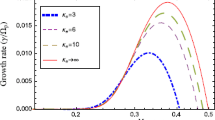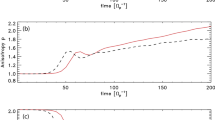Abstract
Relative drifts between different species or particle populations are characteristic to solar plasma outflows, e.g., in the fast streams of the solar winds, coronal mass ejections and interplanetary shocks. This paper characterizes the dispersion and stability of the low-beta alpha/proton drifts in the absence of any intrinsic thermal anisotropies, which are usually invoked in order to stimulate various instabilities. The dispersion relations derived here describe the full spectrum of instabilities and their variations with the angle of propagation and plasma parameters. The results unveil a potential competition between instabilities of the electromagnetic proton cyclotron and alpha cyclotron modes. For conditions specific to a low-beta solar wind, e.g., at low heliocentric distances in the outer corona, the instability operates on the alpha cyclotron branch. The growth rates of the alpha cyclotron mode are systematically stimulated by the (parallel) plasma beta and/or the alpha-proton temperature ratio. One can therefore expect that this instability develops even in the absence of temperature anisotropies, with potential to contribute to a self-consistent regulation of the observed drift of alpha particles.




Similar content being viewed by others
References
Asbridge, J.R., Bame, S.J., Feldman, W.C., Montgomery, M.D.: J. Geophys. Res. 81(16), 2719 (1976). https://doi.org/10.1029/JA081i016p02719
Gary, S.P.: Theory of Space Plasma Microinstabilities. Cambridge University Press, Cambridge (1993). https://doi.org/10.1017/CBO9780511551512
Gary, S.P., Yin, L., Winske, D., Reisenfeld, D.B.: J. Geophys. Res. Space Phys. 105(A9), 20989 (2000a)
Gary, S.P., Yin, L., Winske, D., Reisenfeld, D.B.: Geophys. Res. Lett. 27(9), 1355 (2000b)
Gomberoff, L., Valdivia, J.A.: J. Geophys. Res. Space Phys. 108(A1), 1050 (2003)
Kasper, J.C., Stevens, M.L., Lazarus, A.J., Steinberg, J.T., Ogilvie, K.W.: Astrophys. J. 660(1), 901 (2007)
Kohl, J.L., Noci, G., Antonucci, E., Tondello, G., Huber, M.C.E., Cranmer, S.R., Strachan, L., Panasyuk, A.V., Gardner, L.D., Romoli, M., Fineschi, S., Dobrzycka, D., Raymond, J.C., Nicolosi, P., Siegmund, O.H.W., Spadaro, D., Benna, C., Ciaravella, A., Giordano, S., Habbal, S.R., Karovska, M., Li, X., Martin, R., Michels, J.G., Modigliani, A., Naletto, G., Neal, R.H.O., Pernechele, C., Poletto, G., Smith, P.L., Suleiman, R.M.: Astrophys. J. 501(1), 127 (1998). https://doi.org/10.1086/311434
Li, X., Habbal, S.R.: Sol. Phys. 190(1–2), 485 (1999). https://doi.org/10.1023/A:1005288832535
Maneva, Y.G., Araneda, J.A., Marsch, E.: Astrophys. J. 783(2), 139 (2014). https://doi.org/10.1088/0004-637x/783/2/139
Marsch, E.: Kinetic Physics of the Solar Wind Plasma. Physics and Chemistry in Space, vol. 21, p. 45. Springer, Berlin (1991)
Marsch, E.: Living Rev. Sol. Phys. 3(1), 1 (2006). https://doi.org/10.12942/lrsp-2006-1
Marsch, E., Livi, S.: J. Geophys. Res. 92(A7), 7263 (1987). https://doi.org/10.1029/JA092iA07p07263
Marsch, E., Mühlhäuser, K.-H., Rosenbauer, H., Schwenn, R., Neubauer, F.: J. Geophys. Res. 87(A1), 35 (1982)
Maruca, B.A., Kasper, J.C., Gary, S.P.: Astrophys. J. 748(2), 137 (2012)
Matteini, L., Hellinger, P., Goldstein, B.E., Landi, S., Velli, M., Neugebauer, M.: J. Geophys. Res. 118(6), 2771 (2013). https://doi.org/10.1002/jgra.50320
Melrose, D.B.: Instabilities in Space and Laboratory Plasmas. Cambridge University Press, Cambridge (1986). https://doi.org/10.1017/CBO9780511564123
Neugebauer, M.: Fundam. Cosm. Phys. 7, 131 (1981)
Reisenfeld, D.B., Gary, S.P., Gosling, J.T., Steinberg, J.T., McComas, D.J., Goldstein, B.E., Neugebauer, M.: J. Geophys. Res. 106(A4), 5693 (2001)
Revathy, P.: J. Geophys. Res. 83(A12), 5750 (1978)
Robbins, D.E., Hundhausen, A.J., Bame, S.J.: J. Geophys. Res. 75(7), 1178 (1970)
Stansby, D., Perrone, D., Matteini, L., Horbury, T.S., Salem, C.S.: Astron. Astrophys. 623, 2 (2019). https://doi.org/10.1051/0004-6361/201834900
Verscharen, D., Bourouaine, S., Chandran, B.D.G., Maruca, B.A.: Astrophys. J. 773(1), 8 (2013)
von Steiger, R., Geiss, J., Gloeckler, G., Galvin, A.B.: Space Sci. Rev. 72(1), 71 (1995). https://doi.org/10.1007/BF00768756
Acknowledgements
The authors acknowledge support from the Katholieke Universiteit Leuven (Grant No. SF/17/007, 2018), Ruhr-University Bochum, and Alexander von Humboldt Foundation. These results were obtained in the framework of the projects SCHL 201/35-1 (DFG–German Research Foundation), C14/19/089 (KU Leuven), G0A2316N (FWO-Vlaanderen), and C 90347 (ESA Prodex 9). M.A.R. acknowledges Punjab Higher Education Commission (PHEC) Pakistan for granted Postdoctoral Fellowship FY 2017-18. S.M. Shaaban gratefully acknowledges support by a Postdoctoral Fellowship (Grant No. 12Z6218N) of the Research Foundation Flanders (FWO-Belgium). P.H.Y. acknowledges NASA Grant NNH18ZDA001N-HSR and NSF Grant 1842643 to the University of Maryland, and the BK21 plus program from the National Research Foundation (NRF), Korea, to Kyung Hee University.
Author information
Authors and Affiliations
Corresponding author
Additional information
Publisher’s Note
Springer Nature remains neutral with regard to jurisdictional claims in published maps and institutional affiliations.
Appendices
Appendix A: Polarization vector
For an ambient magnetic field vector directed along \(z\) axis, \(\hat{\mathbf{b}}={\mathbf{B}}_{0}/|B_{0}|=\hat{\mathbf{z}}\) and the wave vector lying in \(xz\) plane, \({\mathbf{k}}=k_{\perp }\hat{\mathbf{x}}+k_{\parallel }\hat{\mathbf{z}} =\hat{\mathbf{x}}k \sin \theta +\hat{\mathbf{z}}k\cos \theta \), we define three orthogonal unit vectors, following (Melrose 1986), \(\hat{\boldsymbol{\kappa }}=\hat{\mathbf{x}}\sin \theta +\hat{\mathbf{z}}\cos \theta \), \(\hat{\mathbf{a}}=\hat{\mathbf{y}}\), and \(\hat{\mathbf{t}}=\hat{\mathbf{x}}\cos \theta -\hat{\mathbf{z}}\sin \theta \). Then the unit wave electric field vector is given by
Making use of linear wave equation,
it is possible to obtain
Upon direct comparison with Eq. (14) one may identify
where \(A = \epsilon _{xx}\sin ^{2}\theta +\epsilon _{zz}\cos ^{2}\theta \). Upon making use of Eq. (5), we further obtain
where various quantities, \(P_{\pm }\), \(Q_{\pm }\), and \(D\), as well as normalized wave number and frequency, \(q=ck/\omega _{pp}\) and \(x=\omega /\Omega _{p}\), are defined in Eq. (8).
Appendix B: Parameter \(R\)
In the growth rate expression (9) appears a quantity \(\partial (\omega ^{2}N^{2})/\partial \omega \), which in normalized form, is defined by
Making use of Eqs. (6) and (8), the desired quantity \(R\) can readily be computed as
Rights and permissions
About this article
Cite this article
Rehman, M.A., Shaaban, S.M., Yoon, P.H. et al. Electromagnetic instabilities of low-beta alpha/proton beams in space plasmas. Astrophys Space Sci 365, 107 (2020). https://doi.org/10.1007/s10509-020-03823-4
Received:
Accepted:
Published:
DOI: https://doi.org/10.1007/s10509-020-03823-4




